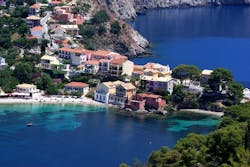About the author:
Lauren Estes | Managing Editor | [email protected]
Kaliméra! I’ve just returned from the Greek island of Kefalonia, the largest island in the Ionian Sea. While I happily spent most of my vacation relaxing on a beach, my curiosity was piqued upon arrival when I noticed the sinks in the island’s airport had signs warning the water was not potable.
When I arrived at my accommodations for the trip, my host immediately greeted me with a large bottle of water. When I asked him about the island’s water quality, he told me that while many homes on the island use groundwater, the islanders prefer to not drink the water from the tap, particularly during the summer when seawater can infiltrate the groundwater supply, causing it to have a high mineral content. When I asked him if any of the islanders use filtration systems, he laughed and told me everyone simply drinks bottled water.
I did my own research and found surprisingly little information about water quality on the island. While most areas use groundwater, there are some remote villages not connected to the water system that bring water in via tanker trucks. Until recently, the island’s capital, Argostoli, did not have access to clean drinking water. A new water treatment plant was inaugurated on World Water Day, March 22, this past year, according to The Kefalonia Pulse.
Other Greek islands, like Santorini, have desalination plants and bring in water from the mainland, as well. However, many islanders still prefer to drink bottled water because of taste concerns.
Coinciding with my trip, the Water Resources Institute recently published the Aqueduct Water Risk Atlas report, which ranks the most water scarce countries in the world and lists Greece as #26.
When I finally left Kefalonia after two beautiful weeks of sand and sun, I was sad to say farewell but happy to turn on the tap.
